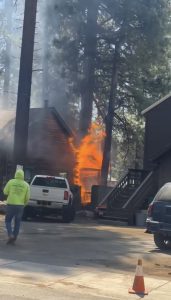New project will help recovery of endangered Sierra Nevada red fox

Provided/Tim Hiller/Wildlife Ecology Institute
Wildlife Ecology Institute was awarded a federal grant of $236,000 to work with project partners, California Department of Fish and Wildlife, Sequoia and Kings Canyon National Parks, and U.S. Fish and Wildlife Service, to advance recovery efforts for the Sierra Nevada red fox.
These unique foxes are specially adapted to high-elevation areas from the Sierra Nevada of California north through the Cascades to northern Oregon. In California, red foxes exist in very small and isolated populations, which requires specific recovery actions to assure their persistence.
“Fewer than 100 SNRF are believed to currently exist in their historic range in California, which prompted the U.S. Fish and Wildlife Service to recently list this montane subspecies of red fox as endangered in the Sierra Nevada of California,” stated Tim Hiller, WEI executive director. “In fact, Oregon Department of Fish and Wildlife and WEI recently completed another project in the Oregon Cascades, and we are tallying results. With so few SNRF in California, Wildlife Ecology Institute and project partners now have the opportunity to see how best to apply the knowledge from Oregon to benefit conservation and recovery of the endangered SNRF in California.”
CDFW recently led the effort to complete a range-wide conservation strategy for SNRF, an effort in which WEI and many others were involved.
“This conservation strategy outlines recovery steps and priorities, including potential reintroduction efforts,” stated Chris Stermer, CDFW biologist who has been researching SNRF for many years. “This new project is in the southern Sierra Nevada, which is a priority recovery location due to vast amounts of protected alpine habitat. Further, SNRF were very recently detected near Taboose Pass on the eastern boundary of SEKI, a first for that region since the 1930s, which elevates the importance of increasing our survey efforts in that region through this new project.”
“We are excited to have documented evidence of this spectacular rare native carnivore back in alpine areas of SEKI after many, many years,” added Rebecca Green, SEKI wildlife biologist.
Motion-sensing infrared trail cameras will be strategically placed in areas to collect digital data to further determine whether SNRF are present.
“If an SNRF is in an area, we need to do everything possible to detect it. Like many animals, scent matters, and placing a skunk-based scent near the cameras has a dramatic effect for attracting all kinds of wildlife, including SNRF,” said Tim Hiller, Wildlife Ecology Institute and principal investigator of the project. “We will also place hair-snagging devices at camera locations, and collect any scat, and even urine collected from snow, to use for DNA analysis, as we need to rely on a diverse set of tools as part of these recovery steps.”

Provided/C. Stermer/California Department of Fish and Wildlife
Scat and other collected samples will be sent to a laboratory for DNA extraction. DNA analysis can verify detection of an SNRF, catalog individual animals, determine their gender, and evaluate genetic relationships across the study area and beyond. Wildlife Ecology Institute is also exploring the option of using professionally trained scent-detection dogs during a later stage of this project. These dogs are highly trained and used on surveys specifically focused on locating SNRF scat in these challenging and remote areas.
Wildlife Ecology Institute and project partners have secured federal funding to initiate this project in 2023.
“We greatly appreciate the funding and other support provided by U.S. Fish and Wildlife Service to support this project,” said Hiller. “We continue to seek additional funding to supplement these resources and further expand the scientific basis to conserve this unique and rare species.”
“This work will help us greatly expand our understanding of SNRF and is a critical piece that supports their population recovery in the southern Sierra Nevada,” stated Tyler Coleman, SEKI wildlife biologist.More information about Wildlife Ecology Institute and opportunities to provide support for this project are available at https://www.wildlifeecology.org/snrf_ca.html.
Source: WEI
Support Local Journalism


Support Local Journalism
Readers around Lake Tahoe, Truckee, and beyond make the Sierra Sun's work possible. Your financial contribution supports our efforts to deliver quality, locally relevant journalism.
Now more than ever, your support is critical to help us keep our community informed about the evolving coronavirus pandemic and the impact it is having locally. Every contribution, however large or small, will make a difference.
Your donation will help us continue to cover COVID-19 and our other vital local news.









